1993 CHEVROLET CAVALIER service
[x] Cancel search: servicePage 155 of 308
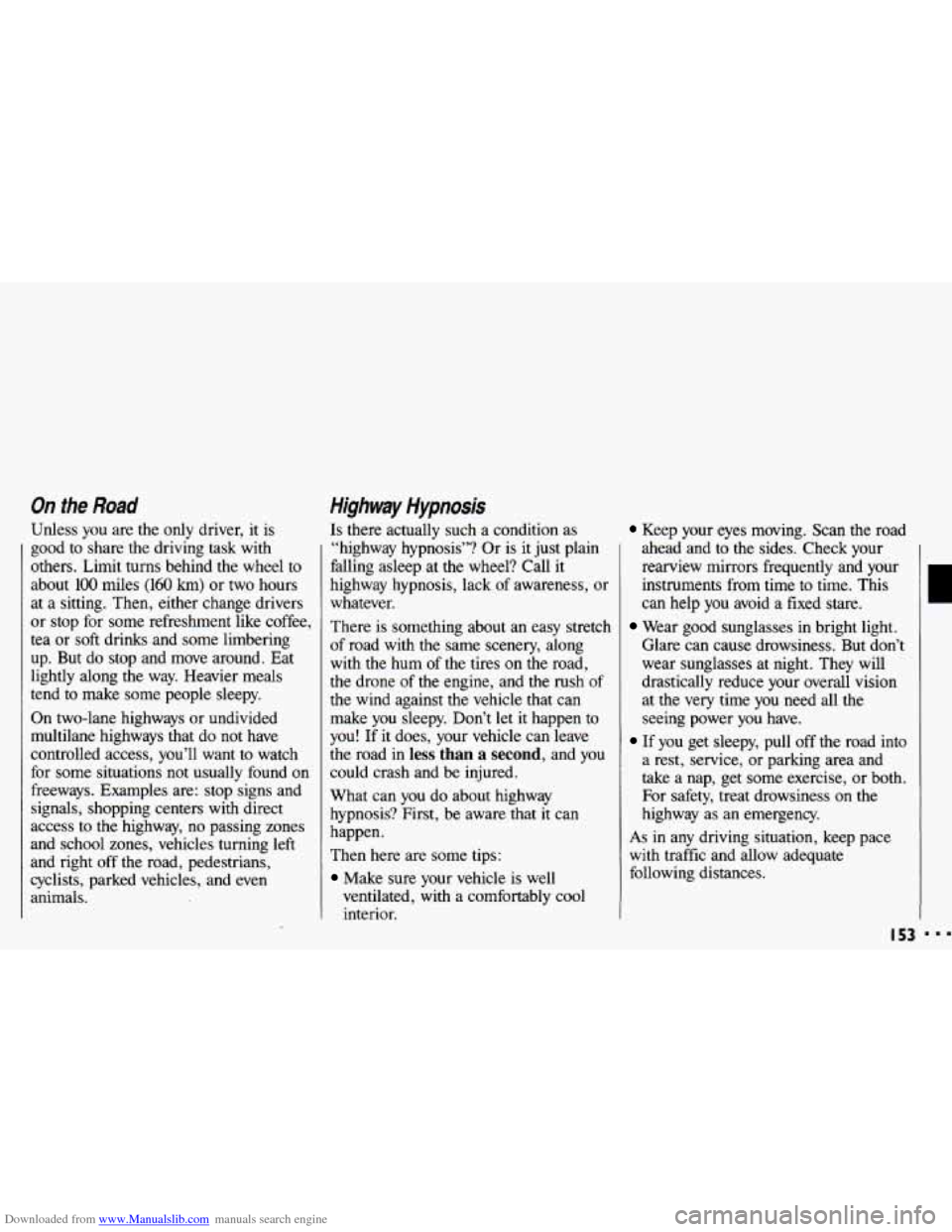
Downloaded from www.Manualslib.com manuals search engine On the Road
Unless you are the only driver, it is
good to share the driving
task with
others. Limit turns behind the wheel
to
about 100 miles (160 km) or two hours
at a sitting. Then, either change drivers
or stop for some refreshment like coffee,
tea or soft drinks and some limbering
up. But do stop and move around. Eat
lightly along the way. Heavier meals
tend to make some people sleepy.
On two-lane highways or undivided
multilane highways that do
not have
controlled access, you’ll want
to watch
for some situations not usually found on
freeways. Examples are: stop signs and
signals, shopping centers with direct
access to the highway, no passing zones
and school zones, vehicles turning left
and right off the road, pedestrians,
cyclists, parked vehicles, and even
animals.
Highway Hypnosis
Is there actually such a condition as
“highway hypnosis”?
Or is it just plain
falling asleep at the wheel? Call it
highway hypnosis, lack
of awareness, or
whatever.
There is something about an easy stretch
of road with the same scenery, along
with the hum
of the tires on the road,
the drone
of the engine, and the rush of
the wind against the vehicle that can
make you sleepy. Don’t let it happen to
you! If it does, your vehicle can leave
the road
in less than a second, and you
could crash and be injured.
What can
you do about highway
hypnosis? First, be aware that it can
happen.
Then here are some tips:
Make sure your vehicle is well
ventilated, with a comfortably cool
interior.
Keep your eyes moving. Scan the road
ahead and to the sides. Check your
rearview mirrors frequently and your
instruments from time to time. This
can help you avoid a fixed stare.
Wear good sunglasses in bright light.
Glare can cause drowsiness. But don’t
wear sunglasses at night. They will
drastically reduce your overall vision
at the very time you need
all the
seeing power you have.
If you get sleepy, pull off the road into
a rest, service, or parking area and
take a nap, get some exercise, or both.
For safety, treat drowsiness on the
highway as an emergency.
As in any driving situation, keep pace
with traffic and allow adequate
following distances.
L
Page 170 of 308
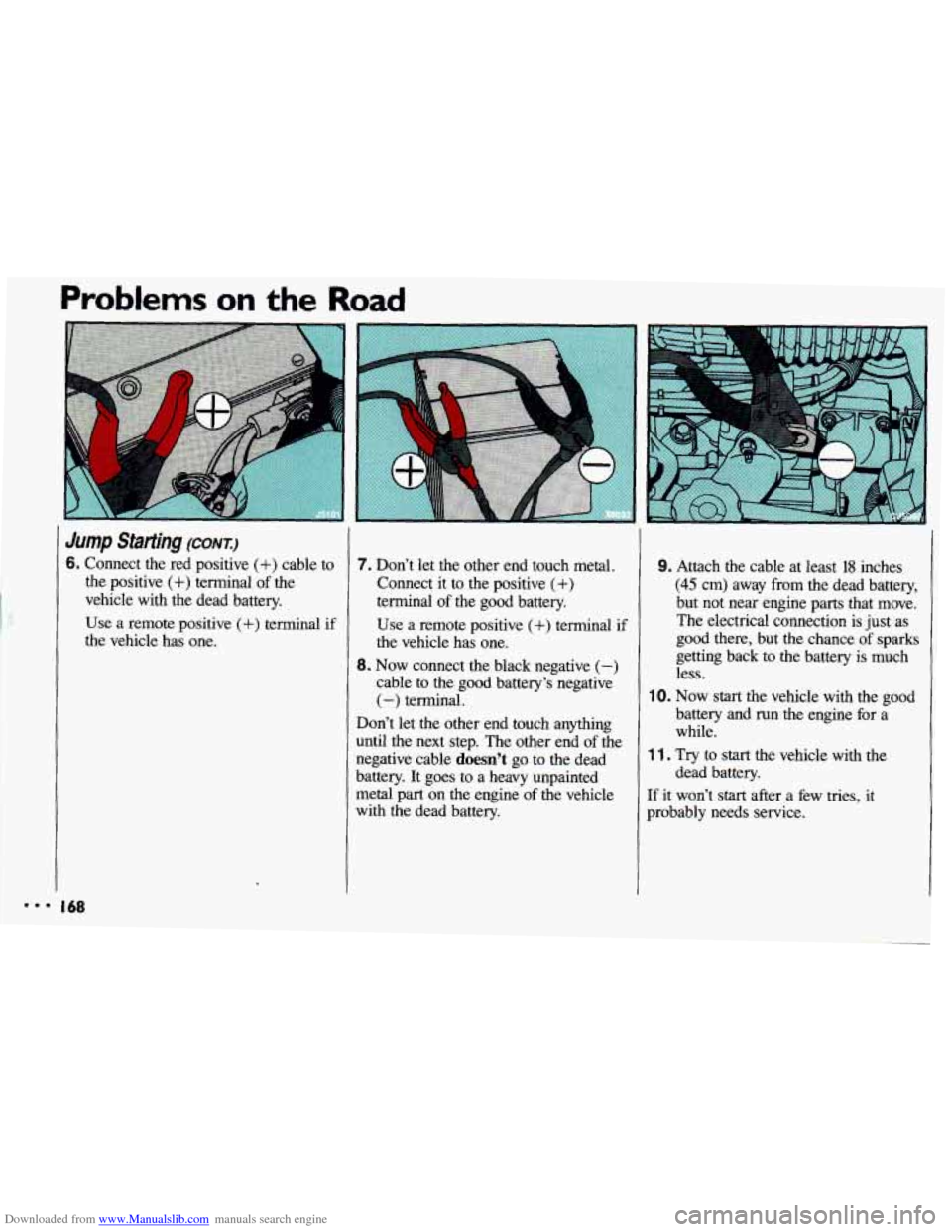
Downloaded from www.Manualslib.com manuals search engine Problems on the Road
Jump Starting (conrr.)
6. Connect the red positive (+) cable to
the positive
(+) terminal of the
vehicle with the dead battery.
Use a remote positive (+) terminal if
the vehicle has one.
7. Don’t let the other end touch metal.
Connect it to the positive
(+)
terminal of the good battery.
Use a remote positive
(+) terminal if
the vehicle has one.
6. Now connect the black negative (-)
cable to the good battery’s negative
(-) terminal.
Don’t let the other end touch anything
until
the next step. The other end of the
negative cable
doesn’t go to the dead
battery. It goes to a heavy unpainted
metal part on the engine of the vehicle
with the dead battery.
9. Attach the cable at least 18 inches
(45 cm) away from the dead battery,
but not near engine parts that move.
The electrical connection is just as
good there, but the chance of sparks
getting back to the battery is much
less.
10. Now start the vehicle with the good
battery and run the engine for a
while.
1 1. Try to start the vehicle with the
dead battery.
If it won’t start after a few tries, it
probablv needs service.
Page 171 of 308
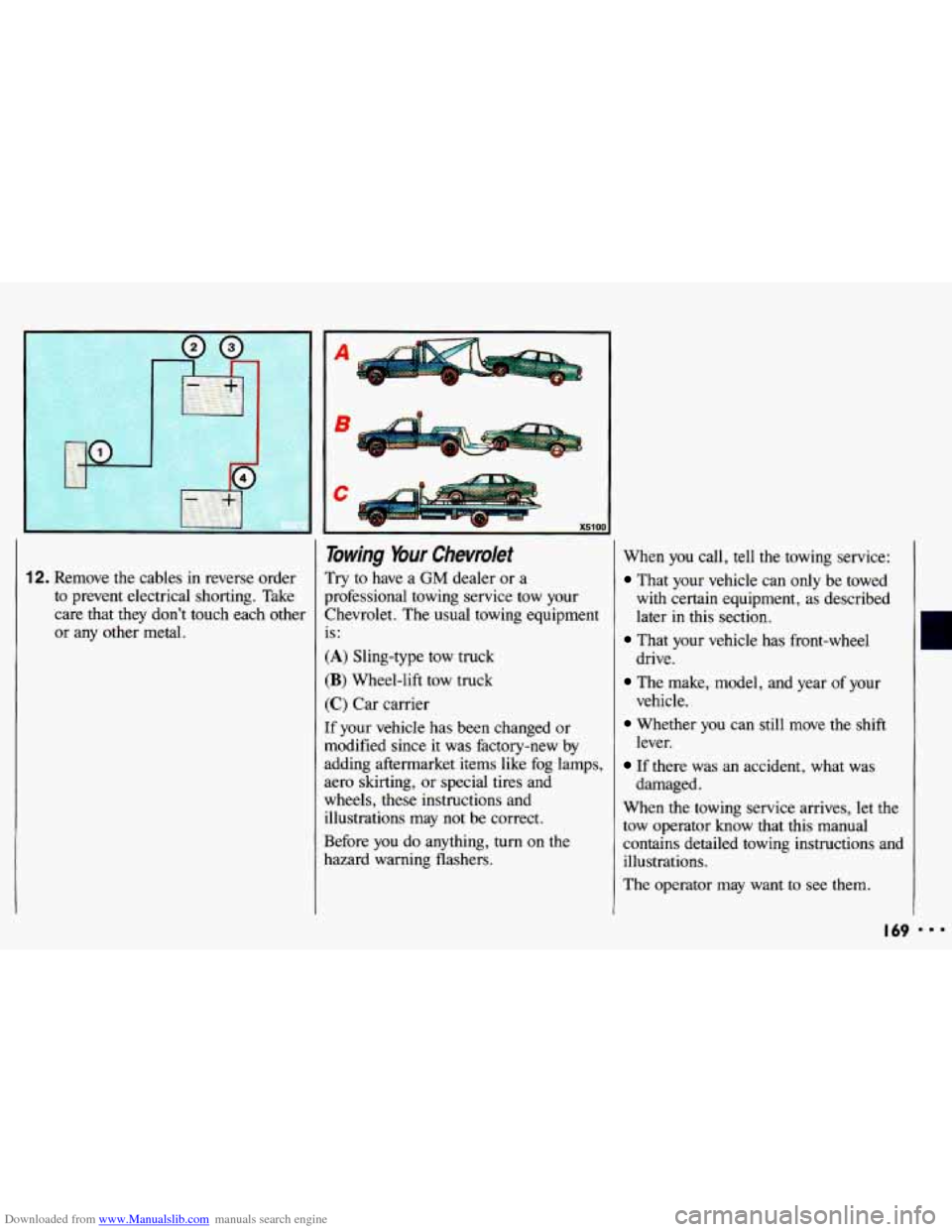
Downloaded from www.Manualslib.com manuals search engine 12. Remove the cables in reverse order
to prevent electrical shorting. Take
care that they don't touch each other
or any other metal.
I
Towing Your Chevrolet
Try to have a GM dealer or a
professional towing service tow your
Chevrolet. The usual towing equipment
is:
(A) Sling-type tow truck
(B) Wheel-lift tow truck
(C) Car carrier
If your vehicle has been changed or
modified since it was factory-new by
adding aftermarket items like fog lamps,
aero skirting, or special tires and
wheels, these instructions and illustrations may not be correct.
Before you do anything, turn on the
hazard warning flashers. When
you call, tell the towing service:
That your vehicle can only be towed
with certain equipment,
as described
later
in this section.
drive.
vehicle. lever.
damaged.
That your vehicle has front-wheel
The make, model, and year of your
Whether you can still move the shift
If there was an accident, what was
When the towing service arrives, let the
tow operator know that this manual
contains detailed towing instructions and
illustrations.
The operator may want to see them.
I69
Page 172 of 308
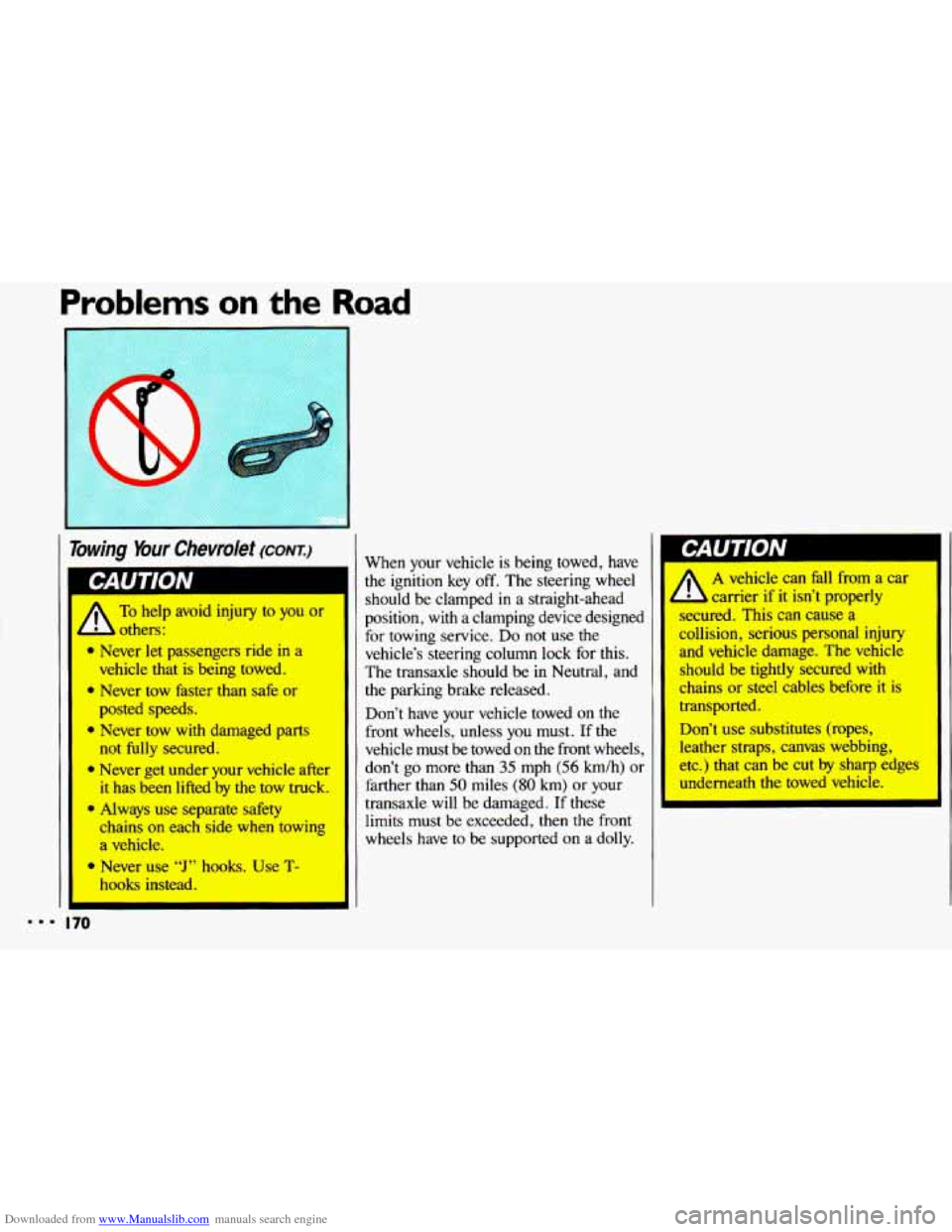
Downloaded from www.Manualslib.com manuals search engine Problems on the Road
bwing Your Chevrolet (CONI)
To help avoid injury to you or
lers:
a Never let passengers ride in a
vehicle that is being towed.
a Never tow faster than safe or
posted speeds.
* Never tow with damaged parts
not fully secured.
* Never get under your vehicle after
it
has been lifted by the tow truck.
* Always use separate safety
chains on each side when towing
a vehicle.
Never use
“J” hooks. Use T-
hooks instead.
the ignition key off. The steering wheel
should be clamped
in a straight-ahead
position,
with a clamping device designed
for towing service. Do not use the
vehicle’s steering column lock for this.
The transaxle should be
in Neutral, and
the parking brake released.
Don’t have your vehicle towed on the
front wheels, unless
you must. If the
vehicle must be towed on the front wheels,
don’t go more than
35 mph (56 km/h) or
farther than
50 miles (80 km) or your
transaxle will be damaged. If these
limits must be exceeded, then
the front
wheels have to be supported on a dolly.
p-AU I IUN I
A vehicle can fall from a car
carrier if it isn’t properly
secured. This can cause a
collision, serious personal injury
and vehicle damage. The vehicle
should be tightly secured with
chains or steel cables before it is
transported.
Don’t use substitutes (ropes,
leather straps, canvas webbing,
etc.) that can be cut
by sharp edges
underneath
the towed vehicle.
A
mmm 170
Page 177 of 308

Downloaded from www.Manualslib.com manuals search engine If you get the overheat warning with no
sign
of steam, try this for a minute or so:
1. If you have an air conditioner, turn it
2. Turn on your heater to full hot at the
off.
highest fan speed and open the window as necessary.
3. Try to keep your engine under load
(in a drive gear where the engine
runs slower).
If
you no longer have the overheat
warning, you can drive. Just to be safe,
drive slower for about ten minutes. If
the warning doesn’t come back on, you
can drive normally.
If the warning continues, pull over, stop, and park your vehicle right away. If there’s
still no sign of steam, you can
idle the engine for two or three minutes
while you’re parked, to see
if the
warning stops. But then, if you still have
the warning, TURN
OFF THE
ENGINE AND
GET EVERYONE
OUT OF THE VEHICLE until it cools
down.
You may decide not to
lift the hood but
to get service help right away.
If you have
a 2.2L L4 engine, your
engine coolant system
will have a
coolant recovery
tank. If you have a 3.1L
V6 engine, your engine coolant system
will have a coolant surge tank.
There are important differences between
these two cooling systems. Read this section carefully.
Cooling System-2.2L LA Engine
When you decide it’s safe to lift the
hood, here’s what you’ll see:
(A) Coolant recovery tank
(B) Radiator pressure cap
(C) Electric engine fan
a An electric fan under the hood
engine
is not running and can injure
you. Keep hands, clothing and tools
away
from any underhood electric h.
L can start up even when the
If the coolant inside the coolant
recovery tank
is boiling, don’t do
anything else until it cools down.
I75
Page 179 of 308
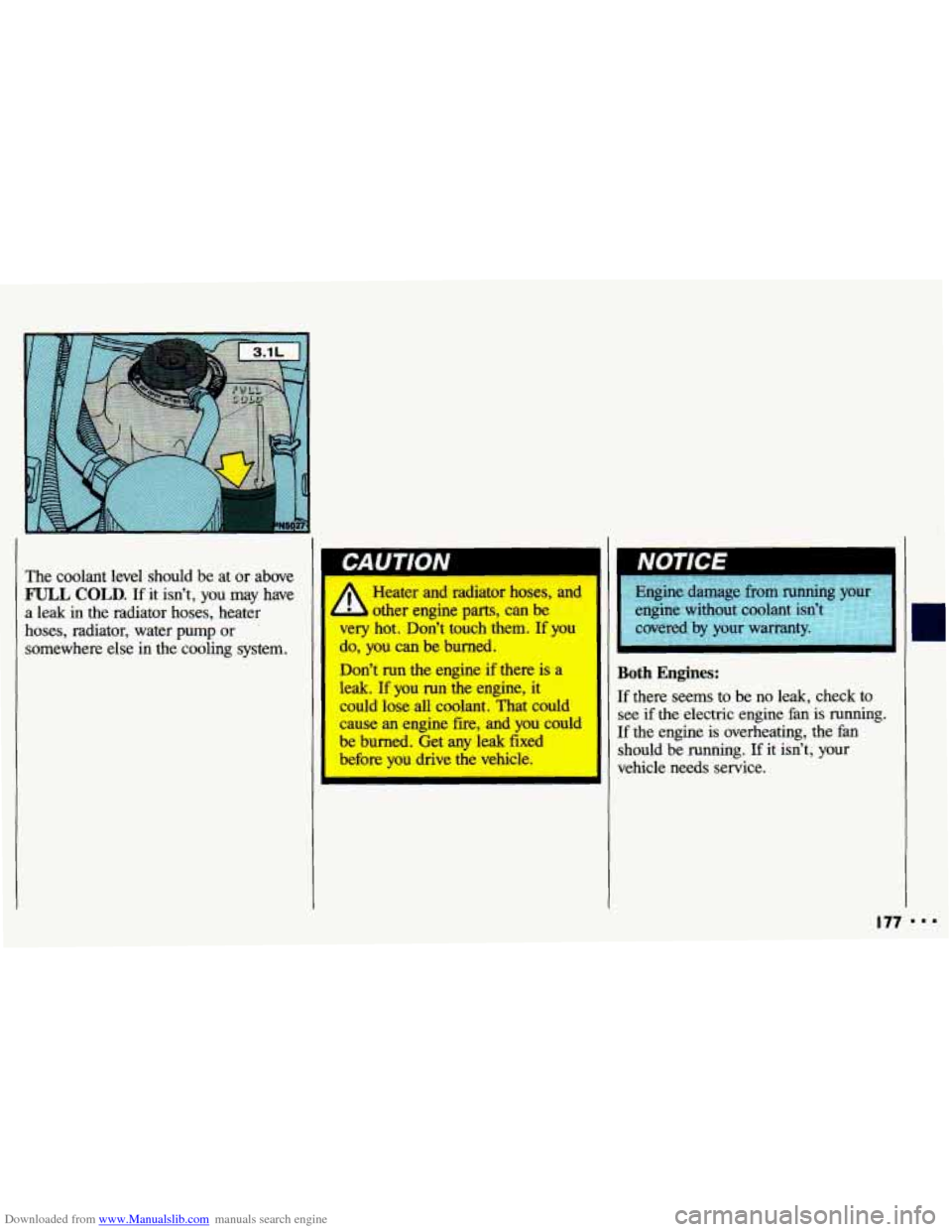
Downloaded from www.Manualslib.com manuals search engine The coolant level should be at or above
FULL COLD. If it isn’t, you may have
a leak
in the radiator hoses, heater
hoses, radiator, water pump
or ’
somewhere else in the cooling system.
, Heater and radiator hoses, and
- b other engine parts, can be
very hot. Don’t touch them.
If you
do,
you can be burned.
Don’t run the engine
if there is a
leak.
If you run the engine, it
could lose all coolant. That could
cause
an engine fire, and you could
be burned. Get any leak
fixed
before you drive the vehicle.
Both Engines:
If there seems to be no leak, check to
see
if the electric engine fan is running.
If the engine is overheating, the fan
should be running. If it isn’t, your
vehicle needs service.
I77 I..
Page 197 of 308
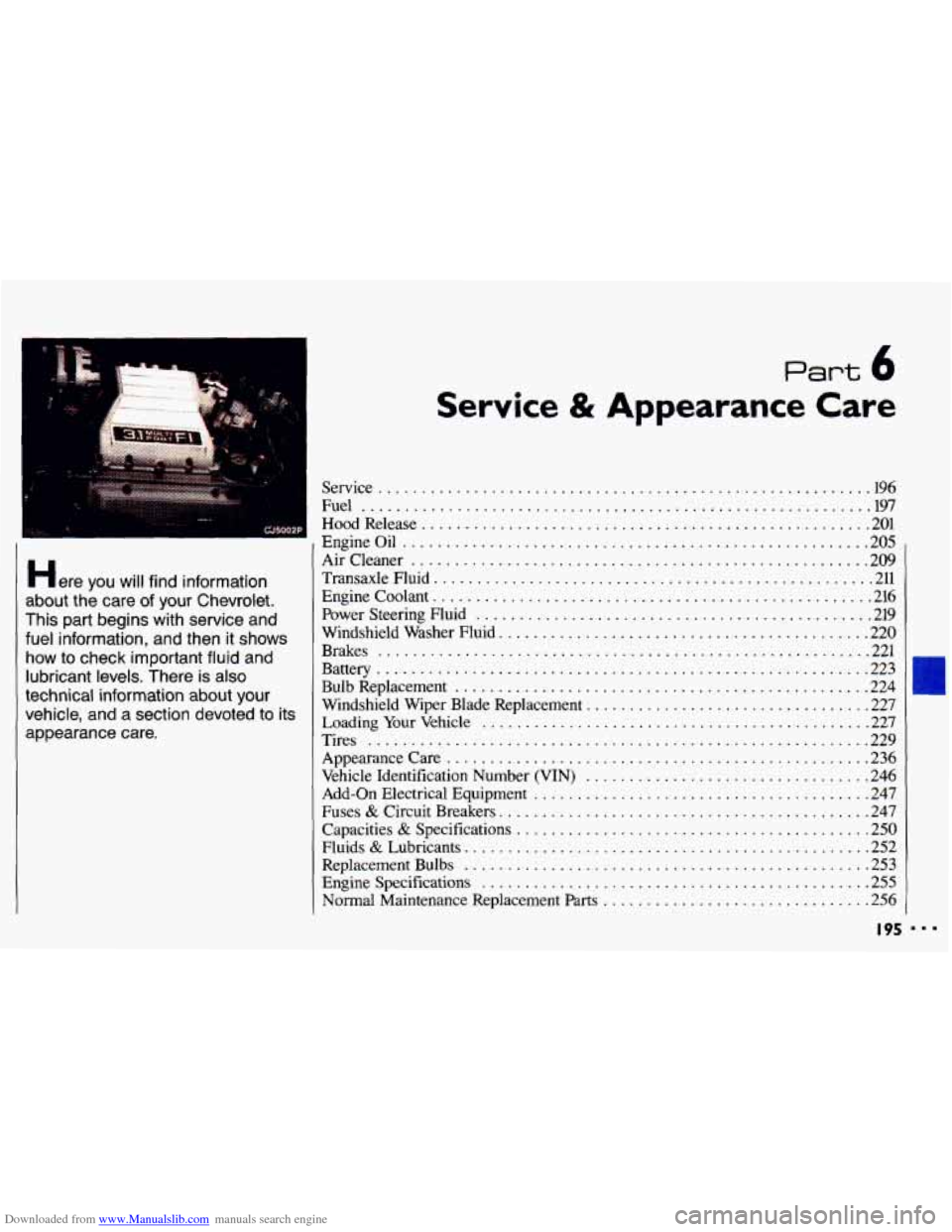
Downloaded from www.Manualslib.com manuals search engine i
.....
.................................. ...................
........ ... . &5
..... ..... .... .. --
' . I .. ~
Here you wit1 find information
about the care
of your Chevrolet .
This part begins with service and
fuel information. and then
it shows
how to check important fluid and
lubricant levels
. There is also
technical information about your
vehicle. and
a section devoted to its
appearance care
.
Part 6
Service & Appearance Care
Service ......................................................... 196
Fuel ........................................................... 197
HoodRelease
.................................................... 201
EngineOil
...................................................... 205
Aircleaner
..................................................... 209
Transaxle Fluid
................................................... 211
Engine Coolant
................................................... 216
Power Steering Fluid
.............................................. 219
Windshield Washer Fluid
........................................... 220
Brakes
......................................................... 221
Battery
......................................................... 223
BulbReplacement
................................................ 224
Windshield Wiper Blade Replacement
................................. 227
Loading
Your Vehicle ............................................. 227
Vehicle Identification Number (VIN)
................................. 246
Add-on Electrical Equipment
....................................... 247
Fuses
& Circuit Breakers ........................................... 247
Capacities & Specifications ......................................... 250
Fluids & Lubricants ............................................... 252
Replacement Bulbs
............................................... 253
Engine Specifications
............................................. 255
Normal Maintenance Replacement
Parts ............................... 256
Tires .......................................................... 229
Appearancecare
................................................. 236
I95
Page 198 of 308
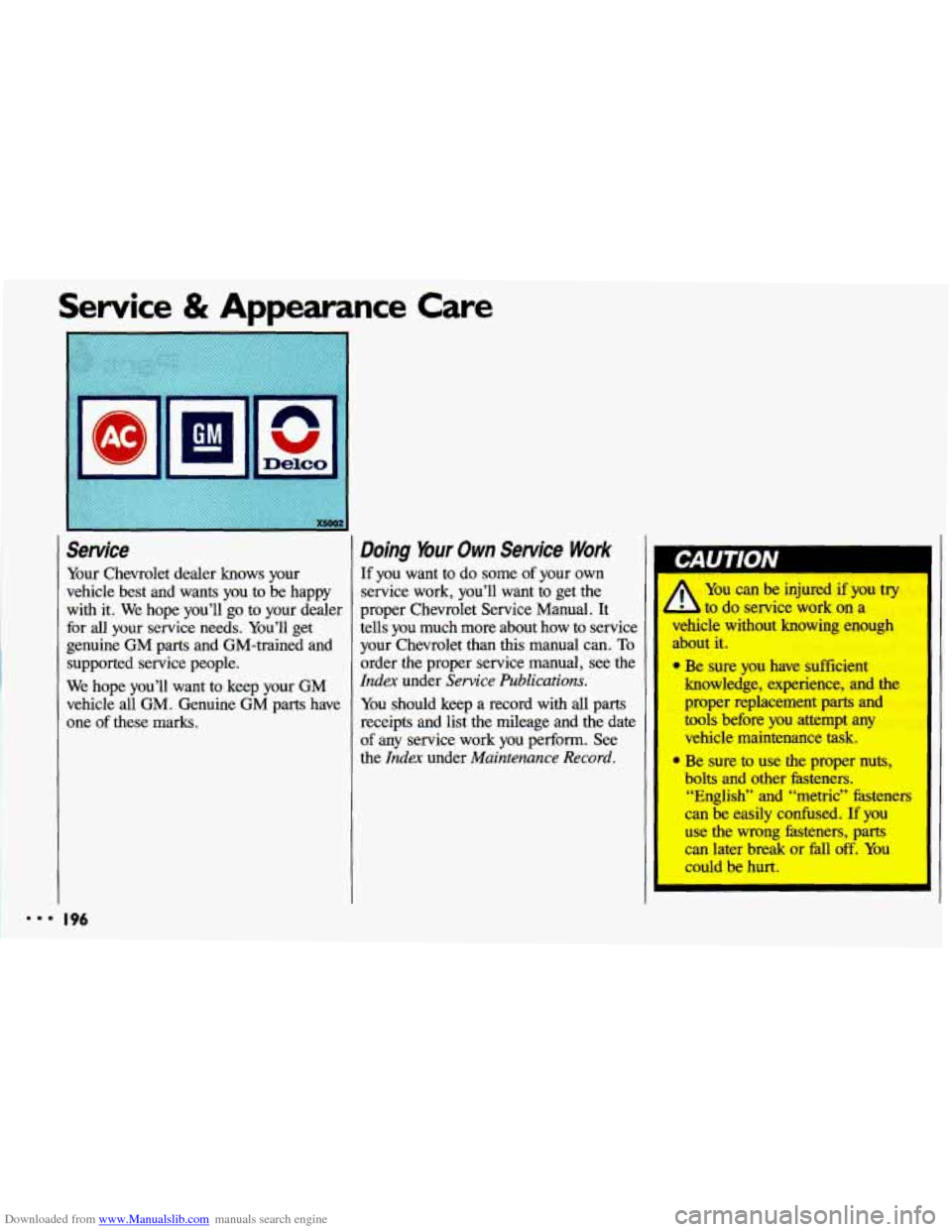
Downloaded from www.Manualslib.com manuals search engine Service & Appearance Care
Service
Your Chevrolet dealer knows your
vehicle best and wants you to be happy
with it. We hope you’ll
go to your dealer
for all your
service needs. You’ll get
genuine GM parts and GM-trained and supported service people.
We hope you’ll want to keep your GM
vehicle all GM. Genuine GM parts have
one of these marks.
196
Doing Your Own Service Work
If you want to do some of your own
service work, you’ll want
to get the
proper Chevrolet Service Manual.
It
tells you much more about how to service
your Chevrolet than this manual can.
To
order the proper service manual, see the
Index under Service Publications.
You should keep a record with all parts
receipts and list the mileage and the date
of any service work you perfom. See
the
Index under Maintenance Record.
-- --
A You can be injured if you try
vemcle without knowing enough
about it.
* Be sue you have sufficient
- I to do service work on a
knowledge, experience, aud the
proper replacement parts and
vehicle maintenance task.
Be sure to use the proper nuts,
bolts and other Edsteners.
“English” and “metric” fhsteflers
can be easily confbsed. If you
use the mng fasteners, parts
can later break or fhll off. You
tools befare you attempt any